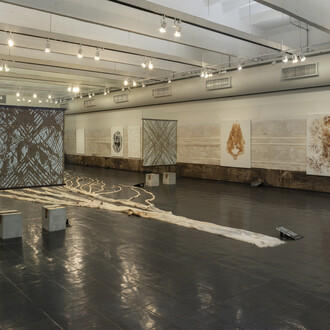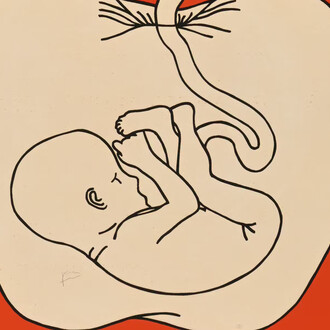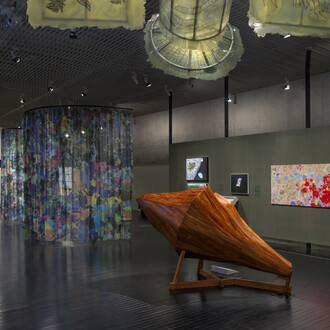The primary vocation of the home as a private living space never denied the presence of art; on the contrary, at least in the Western world (an evidently limited background), forms of decoration and collecting, of domesticating art, had been seen since ancient times. However, its widespread insertion into private contexts (among aristocracies and, later, bourgeoisies) occurred more markedly after the 18th century, followed by a modernity that gave rise to avid and somewhat more comprehensive collecting, also fueling the emergence of commercial galleries. At the same time, public spaces exclusively dedicated to art – museums and institutions – began to emerge, completely distinct from residences, academic halls and palaces, and churches with frescoes and altarpieces.
Today, however, the house transformed into an exhibition space does not coincide with any of the spheres where, until recently, we were accustomed to seeing art. The difference between a museum, a gallery, a decorated space or a collector's home and an exhibition-house lies in the shift in the use of space. It is not a white cube; its architectural elements interfere with contemplation and its scale challenges the proportions of contemporary production; its private dimension is strained by public visitation as it is depopulated of residents and occupied only by passing visitors. But this displacement provides fertile ground for discussing and investigating other ways of presenting, reading, and, why not, consuming art. In this setting, the fields of architecture, design, and visual arts are inextricably intertwined: old neighbors who seek to coexist in new ways.
It is in this kind of non-white cube that the exhibition Qualquer forma é outra forma takes place. This is the second project organized by Simões de Assis that reflects on this intersection, combining furniture and visual productions framed by architecture, outside traditional exhibition settings. In 2023, the gallery occupied Casa Gerassi – Paulo Mendes da Rocha's last residential project in Brazil – for three months, presenting a posthumous dialogue between Ione Saldanha and Etel Adnan, which was also accompanied by original designer pieces. For this second initiative, the location could not have been more fitting: the modernist house designed in the late 1930s by Victor Brecheret, one of the most prominent sculptors of the country's modern generation. Conceived as a home and studio, it was later renovated by Rino Levi and today serves as a platform for Apartamento 61, a gallery dedicated to vintage and contemporary design that organizes this exhibition together with Simões de Assis. Here we find the epitome of the confluence-confusion between art, architecture, and design, placing the house in dialogue with 23 Brazilian artists and key names in modern architecture and design, such as Lina Bo Bardi, Joaquim Tenreiro, Sergio Rodrigues, Jorge Zalszupin, Celina Zilberberg, Aurelio Martinez Flores, Lucio Costa, Giancarlo Palanti, and Janete Costa; and contemporary design, with Maximiliano Crovato, Luiz Solano, Paola Muller, and Estúdio Rain.
At some point in history, geometry was separated from nature, dissociating it from the organic essence of things. In mathematics, geometry defines shapes and calculates sizes using formulas deduced millennia ago (by Euclid and Pythagoras and many others after them). But one must keep in mind that even these rational deductions resulted from observations of the natural world, leading to the identification of patterns and proportions that have always been part of the fabric of existence – they are a kind of practical, synthetic summary of the infinite immensity of the perceptible world. With this movement, geometry – measure of the earth – became increasingly confused with rationality or Cartesianism, as if only regular, artificial, or orthogonal shapes could fit into this field. Today, the term is more likely to evoke straight lines, angles, and symmetrical volumes, accuracy, and even rigidity, rather than curves or sinuous gestures; calculations and theorems rather than the contours of mountains or rocks. It turns out that this separation has marked not only the field of science but also that of art. We began to oppose, for example, geometry and expressionism (among other oppositions such as abstraction and figuration), and even to create secondary classifications such as formal and informal abstraction, mixing other concepts as well.
It is worth quickly digressing on the strangeness of classifying something as “geometric abstraction,” since we could consider the abstract to be that which we cannot name, and squares, triangles, circles, etc. are figures, representations, and have precise designations. But regardless of these classificatory tensions, the abstract is more than just what is geometric, and geometry is not just what we can link to mathematics – even though these terms are constantly mixed, even used as synonyms. And the fact is that both geometry and abstraction have proven to be rigid, impervious aesthetic categories, insufficient to contain the complexity of contemporary artistic thought. Within the imprecisions surrounding these and other expressions, a fertile field is revealed for artists who wish to investigate what lies in between, in the gaps and overlaps, in the ambiguities and rivalries, challenging oppositions. In this exhibition, we bring together works that circumvent, expand, or overcome some of these worn-out “polarizations”: here it is possible to be abstract and figurative, geometric and free or gestural, all at the same time. After all, in the field of art, two opposing premises can coexist in harmony; two contrary vectors do not need to cancel each other out.
Taken together, these works do not fully adhere to the constructive, concrete, or neo-concrete lines of Brazilian art history, nor do they fully align themselves with the currents of abstract expressionism, minimalism, or land art. They challenge these standard movements, discussing and articulating other dualities associated with these historical equations: image-language, form-function, natural-artificial, figurative-literal, symbolic-abstract, material-conceptual, physical-metaphysical...
We have artists who seek to organize ideas in concrete form, to spatialize their concepts. These are works whose straight lines harbor optical illusions or organic evocations, as in the case of Alexandre Canônico and Mano Penalva; or whose sinuous lines draw unnameable shapes, as in Mari Ra's painting. There are works whose constituent objects lose their original meaning in the process of appropriation in favor of unprecedented configurations, unusual formulations, as in the case of Claudio Cretti's sculpture Untitled; the bottle and pendulum that form Alexandre da Cunha's Ikebana; and the sledgehammer on the delicate soup plate in Nino Cais' Untitled. Meanwhile, Marcelo Pacheco's Torso and Nelson Leirner's Rural constructivism draw attention for the play on words between title and image. The humor present in these works emerges in other pieces, such as Lenora de Barros' Ping poema series. Meanwhile, some artists employ semantics, figures of speech and structures of language to create tension in the visual field, playing with words as signs and symbols, such as Niobe Xandó with her writing-drawing, Marilá Dardot and her sign evoking emotions and sensations, or even the marks and scribbles reminiscent of cave drawings on Jacque Faus' vase. There are also works of a more subjective nature, such as João Trevisan's monochrome or Mestre Didi's sculpture.
We also have artists who examine the relationships between nature and artificiality, materiality and color, present in non-figurative formalizations, such as in Ione Saldanha's totems, Anderson Borba's relief, Amelia Toledo's Minas de cor (Mines of color), and Suanê's flower forms. These works echo the organic nature of natural materials, such as bamboo, stone, and wood, while also incorporating geometry into their compositions. There are works that make use of industrial and industrialized materials as constitutive and constructive elements, employing a more concrete visual vocabulary, as in the case of Emanoel Araújo's prismatic sculpture, Ana Hortides' lightning piece, and Rodrigo Sassi's concrete reliefs. Finally, other pieces have a more ambiguous essence, residing in the gap between representation and non-representation, such as the abstract landscapes by Marepe and Daniel Acosta, which subvert the function of materials and their meanings – in this case, paper and Formica.
The artists gathered here uniquely articulate concrete and poetic matter, formulating different systems of construction and expression that draw on the multiple facets of geometry: sometimes more rational, sometimes more intuitive, sometimes more organic, sometimes more philosophical. Their works are not bound by predefined classifications and meanings; it is in the confrontation with art history and with the public, in the act of reading the works, that they reveal how they function in the world, the effects they cause, informing (always in new ways) the spaces they occupy or can occupy within the collective syntax of the exhibition and their individual productions. While scientists (and linguists, mathematicians, philosophers, and, why not, curators) try to fit what exists in the world into specific boxes, it is artists who can (and do) invent and give other forms to the universe and everything it contains.
(Text by Julia Lima)













